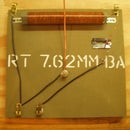Introduction: How to Make Vacuum Tube Breadboarding Sockets.
Even though there is still wide spread interest in experimenting and building projects with vacuum tubes and almost every tube ever made is still available except for the very first ones made, there are none of the old type bread boarding sockets made now. And those that occasionally come available on Ebay are very pricy.
These sockets can be made for $3 each or less if you have some non-working tube equipment that you can scavage the sockets from. Even bought new the sockets should be $2 or so. Add to that a few machine bolts and nuts, a piece of wood for a base and a few feet of hookup wire and you have all you need.
Parts needed for each socket.
(1) 6.5" of 1x4 pine or poplar works well
(1) 8-32 x 1.25 machine screw
(3) 8-32 nut
(3) washers to fit the machine screws
(1) tube socket of the correct type
(2) 1"x .25 tube for socket support
(2) 1.5" wood screws that fit the socket mounting holes
(4) adhesive rubber feet
hookup wire (get some 600 volt insulation wire)
I picked up a box of 100 each of the machine screws, nuts and washers because they were cheaper that way.
Step 1: Cut Wood to Size for Bases.
I made my bases 6.5" long. That's long enough to locate all of the needed terminals and is hefty enough to not move around too much when in use.
Use sand paper and smooth the cut ends and round over the sharp corners.
Most modern tubes have either 7, 8, or 9 pins.
Mark your base with the number of terminals you need. Marking for holes as shown, 1-1/8" horiz. and 1" vertically would server for any of the tubes and make a nice looking symmetrical project.
Drill the holes using an 11/64 size drill or what ever you have that will fit the machine screws. Drill the holes carefully and as straight up as possible. It would be a good idea to use a drill press.
Use the sandpaper again to clean up the holes.
You can finish the wood if desired. Spray lacquer would seal them and prevent them from absorbing moisture from the air. Most projects would not be bothered by this.
Step 2: Insert Machine Bolts to Create Terminals.
From the bottom insert a machine bolt in each hole you drilled. Turn the base back over and drop a washer on each screw and then start a nut on each screw.
Set this assembly aside for now.
Step 3: Solder Pigtails to Socket.
Soldering wire to the socket terminals is much easier if you do it now before you mount the socket to the base. Make sure the length of wire is long enough to reach from the socket to the terminal. Don't strip the outer ends yet. Check to make sure the solder flows properly and make certain you have no shorts.
Step 4: Install Socket and Hook Up Connections.
The socket is secured to the base by two wood screws that go thru the socket mounting holes and capture a piece of plastic tubing cut to the right length to act as a support for the socket. The socket should be installed so the first pin and the last pin are toward the bottom of the base. Use a 1/8" pilot hole for the wood screws.
Spread out the pigtails sort of spider like and starting at socket pin 1 cut to length and strip about 1" of the end of the pigtail. Put the stripped end under the washer on terminal 1 and tighten down the nut. Make certain the all pigtails go to the correct terminal. An automatic wire stripper is a great help in stripping those short pieces of wire.
Use a nut driver or wrench and screw driver to tighten the nut. You may have to retighten the nut later since the wood will crush some, but be careful to not tighten it so tight as to crack or split the wood. Also make certain you don't twist the wire and break the socket.
When you get to this point, your project should look something like mine pictured below.
Step 5: Install Hardware.
To finish the terminal install 2 washers and another nut on each machine screw.
Stick on 4 rubber feet so that the screw heads on the bottom are raised off the surface.
It would be a good idea to apply insulating tape to the bottom so you didn't accidentally cause a short.
You can see how connection to each terminal can be made using clips, barred wires between the washers and tightened down by the nut.
In this view you can also see how the blue plastic tube is used to support the tube socket. The wood screw is screwed thru the middle of the tube and this gives plenty of support to the socket.
Using a tube guide book or data sheets available on the internet you can connect to the different elements of your tube easily using the terminals that you've connected to the tube socket.













